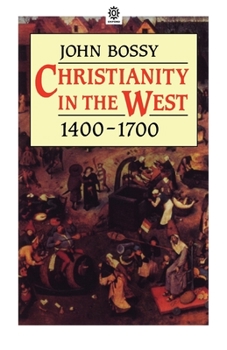Christianity in the West: 1400-1700
Select Format
Select Condition 
Book Overview
A study not of the institution of the Church but of Christianity itself, this book explores the Christian people, their beliefs, and their way of life, providing a new understanding of Western Christianity at the time of the Reformation. Bossy begins with a systematic exposition of traditional or pre-Reformation Christianity, exploring the forces that tended to undermine it, the characteristics of the Protestant and Catholic regimes that superseded it, and the fall-out that resulted from its disintegration.
Format:Paperback
Language:English
ISBN:0192891626
ISBN13:9780192891624
Release Date:June 1985
Publisher:OUP Oxford
Length:210 Pages
Weight:0.40 lbs.
Dimensions:0.5" x 5.0" x 7.8"
Customer Reviews
1 rating
From a body of believers to a body of beliefs
Published by Thriftbooks.com User , 19 years ago
Split into two parts, Christianity in the West addresses two themes: the state of "traditional" Christianity, or Catholicism as practiced by the majority of Western European Christians prior to the sixteenth century, and the changes wrought upon this community by the Reformation. In a book of one hundred and seventy-one pages, Dr. John Bossy uses only seventeen endnotes. This is an important observation, because it emphasizes the familiarity and virtuosity that Bossy displays with his subject. Although the author provides a short preface, the book lacks chapters dedicated to either an introduction or a conclusion. Bossy tells us up front that his book addresses this question: "Supposing that your account of what you call traditional Christianity is roughly correct, what difference does it make to the conventional narrative of sixteenth-century reformations, Protestant or Catholic?" Roughly, Bossy is trying to provide a new perspective on what the medieval society of Christians had before the reforms of the sixteenth century, and what was lost afterwards. And there can be no mistake that Bossy definitely thinks more was lost than gained. Part One: Traditional Christianity examines the beliefs and rites of the medieval Church. Bossy's main theme is that traditional Christianity was not a system of religion thrust from the top down, from theologians onto the peasantry, but rather a rich social construct, equally participated in and constructed by all members of society - peasant, burgher, friar, bishop. The author illustrates this by the use of many examples of traditional belief. Bossy discusses the importance of family to the medieval society, and how this was reflected in a fascination with the extended family of Christ - his mother's relations, his step-cousins, etc. Particular attention is paid to the hierarchy of the seven deadly sins, and the difference between sins of concupiscence (or desire) such as gluttony and lechery, and the sins of aversion, which were pride, anger, and envy. Bossy argues that society's winking tolerance of the sins of desire but the special punishments for the sins of aversion prove that those which would disrupt the community the most were defined as the worst sins. This thesis is strengthened even more when Bossy discusses the formation of the Christian fraternities that proliferated throughout Europe. More than a guild or simple municipal brotherhood, these fraternities banded together for strictly Christian purpose, be it glorification of the Eucharist, transmission of catechism, or public charity in the form of delivering Christian burial to members of the community. In summation, the first eighty-seven pages of the book consist of Bossy describing the many ways in which the diverse body of Western European Christians were united by the collective social belief in the Roman Catholic Church. In contrast, Part Two: Christianity Translated is an eighty page discussion of what changed in Christianit






